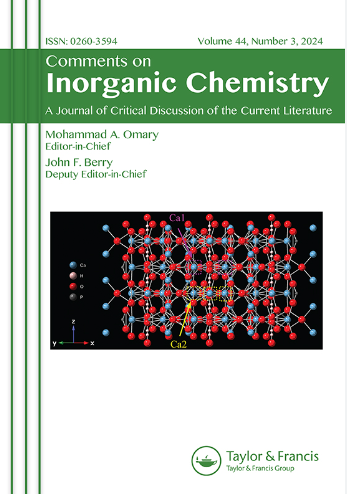Metal-Hydrogen Bond Cleavage Reactions of Transition Metal Hydrides: Hydrogen Atom, Hydride, and Proton Transfer Reactions
IF 3.8
3区 化学
Q1 CHEMISTRY, INORGANIC & NUCLEAR
引用次数: 32
Abstract
Abstract Cleavage of the M-H bond of transition metal hydrides can result in delivery of a hydride (H−), hydrogen atom (H), or proton (H+) to an organic or organo-metallic substrate. Hydrogen atom transfer from a metal hydride to an olefin is an endothermic reaction; the rate at which different metal hydrides carry out this reaction is mainly dependent on the bond dissociation energy of the M-H bond. Hydrogen atom transfer from a metal hydride to a carbon-centered radical is an exothermic reaction in which the rate is largely determined by steric demands of the ligands of the metal hydride, with thermodynamics playing a less important role. Some neutral metal hydrides can function as hydride donors to carbocations. Anionic metal hydrides also exhibit hydridic reactivity, but in some cases the actual M-H bond cleavage step involves hydrogen atom transfer as a part of a radical chain reaction. Neutral metal hydrides can function as nucleophiles and as weakly coordinating ligands to coordinatively unsaturate...过渡金属氢化物的金属-氢键断裂反应:氢原子、氢化物和质子转移反应
过渡金属氢化物的M-H键的断裂可以导致氢化物(H−)、氢原子(H)或质子(H+)传递到有机或有机金属底物上。氢原子从金属氢化物向烯烃的转移是吸热反应;不同金属氢化物进行该反应的速率主要取决于M-H键的键解离能。氢原子从金属氢化物转移到以碳为中心的自由基是一种放热反应,其速度主要取决于金属氢化物配体的空间需求,热力学起的作用较小。一些中性金属氢化物可以作为碳正离子的供体。阴离子金属氢化物也表现出水合反应性,但在某些情况下,实际的M-H键裂解步骤涉及氢原子转移,作为自由基链反应的一部分。中性金属氢化物可以作为亲核试剂和弱配体来配合不饱和金属。
本文章由计算机程序翻译,如有差异,请以英文原文为准。
求助全文
约1分钟内获得全文
求助全文
来源期刊

Comments on Inorganic Chemistry
化学-无机化学与核化学
CiteScore
9.00
自引率
1.90%
发文量
18
审稿时长
>12 weeks
期刊介绍:
Comments on Inorganic Chemistry is intended as a vehicle for authoritatively written critical discussions of inorganic chemistry research. We publish focused articles of any length that critique or comment upon new concepts, or which introduce new interpretations or developments of long-standing concepts. “Comments” may contain critical discussions of previously published work, or original research that critiques existing concepts or introduces novel concepts.
Through the medium of “comments,” the Editors encourage authors in any area of inorganic chemistry - synthesis, structure, spectroscopy, kinetics and mechanisms, theory - to write about their interests in a manner that is both personal and pedagogical. Comments is an excellent platform for younger inorganic chemists whose research is not yet widely known to describe their work, and add to the spectrum of Comments’ author profiles, which includes many well-established inorganic chemists.
 求助内容:
求助内容: 应助结果提醒方式:
应助结果提醒方式:


